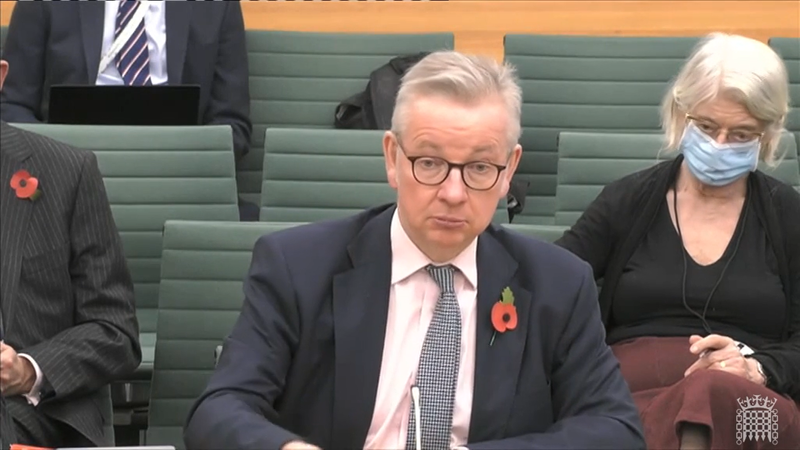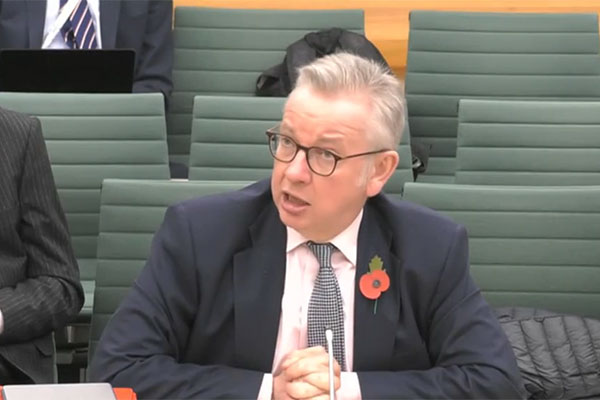You are viewing 1 of your 1 free articles

Jules Birch is an award-winning blogger who writes exclusive articles for Inside Housing
Gove hinted at policy rethinks, but will he be bold enough to undo the knots he has been handed?
The new housing secretary faced committee members for the first time this week and signalled a change of approach in several key areas. But will it be enough, asks Jules Birch
In a two-hour appearance before MPs, Michael Gove made most of the right noises, but can he really come up with meaningful solutions to the intractable problems that come with his new job?
The man in charge of the Department for Levelling Up, Housing and Communities was facing questions from what is still called the Housing, Communities and Local Government Committee. You can watch it back here.
The reorganisation of his department added responsibilities for levelling up and preserving the union to the tangled threads of building safety, planning, homeownership and homelessness that were already crowding his in-tray. You might almost call it a ‘Goveian’ knot.
What was striking was not just Mr Gove’s willingness to engage with committee members but also his multiple hints of bolder answers on the way.
The levelling up secretary signalled pauses and rethinks and resets on several of the most contentious issues he faces. This is reflected in Tuesday morning’s press coverage of his hints that housebuilding targets will be scrapped, his pledge that controversial fire safety advice will be withdrawn soon and his criticism of “overcautious” lending by banks to first-time buyers.
It also became clear that Mr Gove sees a direct link between levelling up and the H side of his brief.
Asked about the geographical breakdown of housing investment, he said: “If you have high demand for land and a high price for homes built on it, you create an incentive to build in areas that already hot in market terms, and that reinforces a geographic trend that we want to rebalance. One of the things I’ve been discussing with Homes England is how we can invest in proper urban regeneration projects outside London and the South East.”
That statement will be strongly welcomed by everyone involved in housing and regeneration elsewhere, but it raises some big questions about levelling up and housing.
Mr Gove followed the prime minister in framing his approach in terms of the Matthew effect (“to them that hath shall be given”), but if housing investment and housebuilding targets are moved away from the areas where affordability problems are most acute, the impact on those most in housing need will surely reinforce it.
“Note that ‘supporting’ councils does not necessarily mean funding them or allowing them to borrow”
The housing secretary denied that planning reform is being abandoned, but also questioned the underlying logic of the argument that the only solution to our housing problems is to build more homes.
Challenged directly on the plight of families trapped in temporary accommodation, Mr Gove said: “I don’t have any problem at all with supporting local government to provide social housing for those most in need.” He added that we should “rid ourselves of some of the attitudes of the 1980s, which reflected a very different world”.
Those are welcome statements but there are more ambiguities here. Note that “supporting” councils does not necessarily mean funding them or allowing them to borrow and that social housing only “for those most in need” does not come close to meeting much broader demand from those the market has failed.
The same mix of bold intent and nagging doubts was evident in the housing secretary’s answers to Labour and Conservative committee members on perhaps the most tangled problem in his Goveian Knot.
The session brought an admission of “a couple of occasions” when his own department had failed by not appreciating the importance of fire safety and not taken the action in the wake of the Lakanal House fire that it should have done.
However, what was really striking was Mr Gove’s much more aggressive tone on pursuing those responsible for putting unsafe materials in residential blocks. He said: “The sheriffs might not have been on the ball, but the cowboys were behaving like cowboys in an unregulated way.”
Challenged on the fundamental question of why leaseholders should have to pay for problems that are not their fault, Mr Gove said that was the first thing he had asked and added “I don’t think they should”.
He said the government has to recognise that “you can’t just make freeholders pay”, that ownership of buildings could be “hard to discern” and that developers had sometimes used special and opaque corporate structures “but to say that leaseholders should pay is just wrong”.
All of which is fine except for the fact that leasehold legislation, inadequate government funding for cladding removal and an ever-growing list of other construction and fire safety problems mean that leaseholders are left holding the bill because everyone else has done a runner.
As former Conservative housing minister Lord Young said in a House of Lords debate last week: “My concern is that the combination of government help, freeholder support and voluntary action by developers still leaves a very substantial shortfall and, unless further steps are taken, we are likely to see bankruptcies, repossessions and evictions of people who took every reasonable precaution to protect their interests.”
“Somehow Mr Gove has to find a way to fund building safety works for the blocks that need them as well as convince mortgage lenders, surveyors and homebuyers that thousands of other blocks caught up in the crisis are safe to lend against and buy”
Lord Young and other peers called for solutions such as more government funding, a compensation scheme similar to the one implemented for victims of a previous building scandal in the Housing Defects Act 1984 and for the adoption of the ‘polluter pays’ principle to the current one.
However, Treasury resistance to any further funding was confirmed in the Spending Review and separately by former housing secretary Robert Jenrick, so what else could change that status quo?
Mr Gove signalled that he was looking not just at developers but also at construction product manufacturers as he cited evidence from the Grenfell Inquiry of value engineering and fiddled product tests.
Applying that to all those involved in the design, specification and construction of all the other blocks that have been drawn into the crisis certainly has the potential to generate extra money.
However, as peer after peer pointed put in last week’s debate as they skewered the inadequacy of the response so far, the government is the only entity capable of taking on well-funded and sometimes multinational corporations.
Mr Gove also signalled a rethink on the controversial loan scheme for leaseholders in blocks smaller than 18 metres, condemned ‘rip-off’ waking watch fees and said the Consolidated Advice Note that triggered the External Wall System crisis would be withdrawn before Christmas.
Somehow Mr Gove has to find a way to fund building safety works for the blocks that need them as well as convince mortgage lenders, surveyors and homebuyers that thousands of other blocks caught up in the crisis are safe to lend against and buy.
On top of that, he admitted that social landlords have been left with a ‘Sophie’s Choice’ between paying for fire safety work and funding new development.
In building safety, as with the rest of his brief, there were welcome rethinks and hints of action to come but few actual commitment. Will the levelling up secretary really be bold enough to cut the Goveian knot?
Jules Birch, columnist, Inside Housing
Sign up for our daily newsletter
Already have an account? Click here to manage your newsletters












